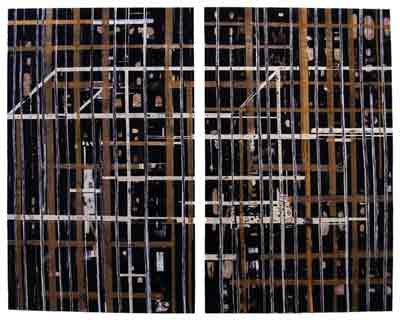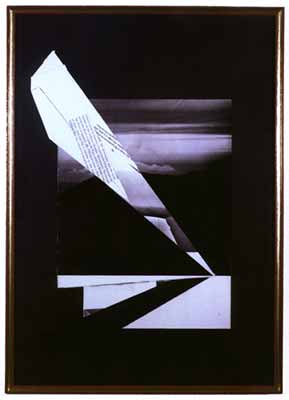
© Mark Handforth
White Lightning,
2004 fluorescent lights, fixtures 14 1/2 x 3 feet -
MH 076
Keep Your Head to the Skyby Don Goddard |
 © Mark Handforth White Lightning, 2004 fluorescent lights, fixtures 14 1/2 x 3 feet - MH 076 |
I don't know where the title comes from, but in the work of all three artists--Katja Strunz, Udomsak Krisanamis, and Mark Handforth--it seems to be the sky from or against which the mind sees and forms. Handforth's Schlosspark is a signpost that has collapsed into a twisted configuration on the ground. Straightened out, the pole would have carried the sign to be seen at some impossible height. Obviously, it wouldn't fit in an art gallery that way, and probably doesn't belong there either. There is nothing written on the sign anyway, so bringing it closer doesn't help, though it makes the pole more interesting, or noticeable. White Lightning is a group of twelve fluorescent light tubes that stretch basically in groups of three from where the wall meets the ceiling to where the wall meets the floor. They angle downward sort of like a lightning strike of which they are a kind of representation, as in a painting. Though their power source is not immediately evident (one simply assumes it), they are not, of course, a real representation, because they do not flash and they are on all the time, except, presumably, when they are turned off or there is some kind of power failure. But that may just be a matter of different perceptions of time duration. In any case, they are fluorescent bulbs, only arranged differently than the usual, perhaps practical, rectilinear manner as seen in the ceiling above the piece. Like the signpost, this is something that is in this form appropriate to an art gallery, but not to the out of doors, where it would compete with another reality, including the sky. |
 © Udomsak Krisanamis Just the 2 of Us, 2004 acrylic, noodle, and tape on canvas 2 panels: each 79 X 48 X 2 inches - UK 313 |
| Krisanamis'
Just the 2 of Us is a diptych of two vertical canvases about three inches
apart but connected in pattern and by the fact that several of the horizontal
stripes seem to continue from one to the other. The canvases present a complicated
grid of horizontal and vertical stripes, overlapping and underlapping, in brown
plastic wrapping tape, white acrylic, and whitish, nearly transparent noodles.
One seems to look through this grid into the blackness behind it, seen as black
rectangles, in which are imbedded arched shapes that appear to be lights, like
those of windows in tall city buildings. The grid is a screen, and there is a
distinct feeling of being trapped on this side of the screen, prevented from
reaching the other side, though a few diagonals create the illusion, as perspective,
that there is some kind of movement between this side and that. Partial words
appear here and there, one of them "ognito," indicating, perhaps, incomplete
perception (cognito) or knowledge. |
 © Katja Strunz Untitled, 2001 collage 19 5/8 x 13 5/7 inches (framed) - KS 010 |
The other world in Katja Strunz's
work is also of this world. But most of the cut-out pieces in a series of fourteen
collages are from books--pictures and text--so there is already an intermediary,
a basis in accumulated knowledge. What has been photographed or written is, for
the most part, what we know. The two most straightforward collages are of a harbor
or marina with boats. The one of the Port of Cassis has the word "Continent"
written in the sky, as though to say that this simple picture contains at least
a part of the whole world if you imagine what lies beyond this port. The other
has the words "yesterday is not today" pasted on it, which might also be read
"today is not yesterday," indicating that what is shown does not represent this
view for all time, an observation that is obvious but nonetheless startling in
regard to all the things we do and do not know. All the rest are constructions
of interpenetrating triangles cut from texts and maps and views of various parts
of the world--seacoasts and cities, Monument Valley and Vancouver Island--that
reassemble the world as a kind of cubist space of the intellect. The triangles
focus the mind and the eye like Renaissance perspective, enabling us to cross
over from one territory to another--all the way from Vancouver to the southeast
United States in one case--piercing from one space into another. But of course
they are also fragments of a much larger and incomprehensible entity, enveloped
by the sky, from and within which most of these views are projected.
Donald Goddard © 2004 |
Art Reviews Listings - Previous Review - Next Review
Art Review - NYArtWorld.com - NYAW.com. All artwork is copyright of the respective owner or artist. All other material © Copyright 2015 New York Art World ®. All Rights Reserved.
New York Art World ® - Back to Top